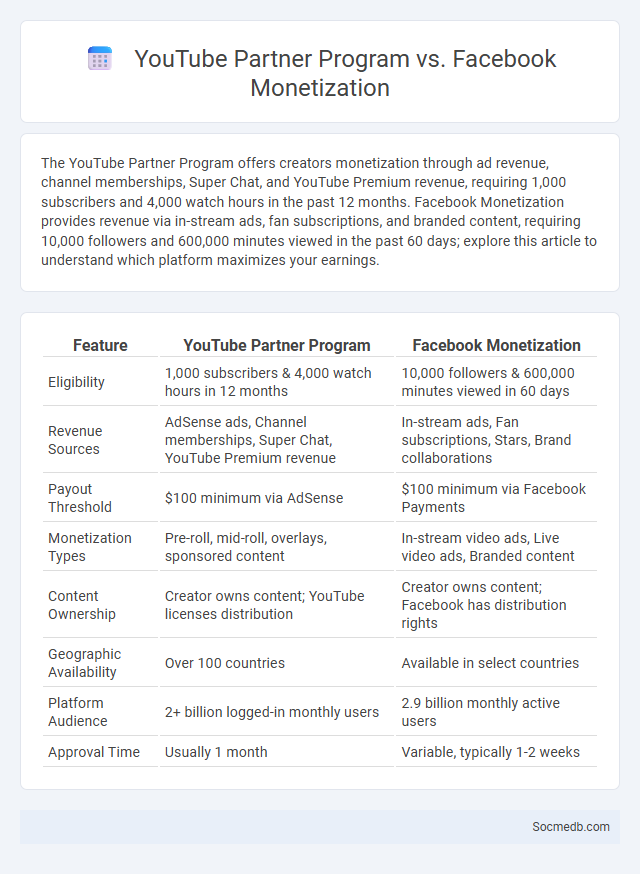
Photo illustration: YouTube Partner Program vs Facebook Monetization
The YouTube Partner Program offers creators monetization through ad revenue, channel memberships, Super Chat, and YouTube Premium revenue, requiring 1,000 subscribers and 4,000 watch hours in the past 12 months. Facebook Monetization provides revenue via in-stream ads, fan subscriptions, and branded content, requiring 10,000 followers and 600,000 minutes viewed in the past 60 days; explore this article to understand which platform maximizes your earnings.
Table of Comparison
| Feature | YouTube Partner Program | Facebook Monetization |
|---|---|---|
| Eligibility | 1,000 subscribers & 4,000 watch hours in 12 months | 10,000 followers & 600,000 minutes viewed in 60 days |
| Revenue Sources | AdSense ads, Channel memberships, Super Chat, YouTube Premium revenue | In-stream ads, Fan subscriptions, Stars, Brand collaborations |
| Payout Threshold | $100 minimum via AdSense | $100 minimum via Facebook Payments |
| Monetization Types | Pre-roll, mid-roll, overlays, sponsored content | In-stream video ads, Live video ads, Branded content |
| Content Ownership | Creator owns content; YouTube licenses distribution | Creator owns content; Facebook has distribution rights |
| Geographic Availability | Over 100 countries | Available in select countries |
| Platform Audience | 2+ billion logged-in monthly users | 2.9 billion monthly active users |
| Approval Time | Usually 1 month | Variable, typically 1-2 weeks |
Introduction to Online Video Monetization
Online video monetization leverages platforms like YouTube, TikTok, and Instagram to generate revenue through advertising, sponsorships, and fan support. Understanding key methods such as AdSense, brand partnerships, and subscription models is essential to maximize your earnings. Optimizing content for engagement and leveraging analytics drives consistent income from your video presence.
Overview of YouTube Partner Program
The YouTube Partner Program (YPP) enables content creators to monetize their videos through ads, channel memberships, and merchandise shelves, given they meet eligibility criteria such as 1,000 subscribers and 4,000 public watch hours in the past 12 months. YPP participants gain access to advanced analytics, copyright management tools, and direct support from YouTube, enhancing content optimization and community engagement. Monetization on YouTube significantly drives revenue for creators by leveraging targeted advertising and fan-based funding features.
Facebook Monetization Program Explained
Facebook Monetization Program enables content creators to earn revenue through ads, fan subscriptions, and in-stream ads on their videos. Your eligibility depends on meeting criteria like follower count, engagement rates, and content compliance with Facebook's Monetization Policies. Leveraging this program maximizes your income potential by transforming your Facebook presence into a sustainable revenue stream.
Key Features: YouTube Partner Program vs Facebook Monetization
The YouTube Partner Program offers creators monetization through ad revenue, channel memberships, super chats, and YouTube Premium revenue sharing, requiring at least 1,000 subscribers and 4,000 watch hours in the past 12 months. Facebook Monetization provides multiple streams including in-stream ads, fan subscriptions, branded content, and Stars, with eligibility criteria like having 10,000 followers and 600,000 total minutes viewed on video content in the last 60 days. YouTube emphasizes audience engagement metrics for revenue access, whereas Facebook focuses on active follower count and video view thresholds to unlock monetization features.
Eligibility Requirements Comparison
Social media platforms have varying eligibility requirements based on factors such as age, location, and user verification processes. Your ability to access features or create accounts depends on meeting criteria like minimum age limits, regional restrictions, and compliance with specific community guidelines. Understanding these differences helps you choose the platform that best suits your needs and ensures a smooth registration experience.
Revenue Streams: Ads, Memberships, and More
Social media platforms generate significant revenue through targeted advertising, leveraging user data to optimize ad placements and increase engagement. Membership models, including premium subscriptions and exclusive content access, offer diversified income sources beyond ads. Emerging trends also incorporate e-commerce integrations and virtual gifts, expanding monetization opportunities and enhancing user experience.
Payout Thresholds and Payment Methods
Social media platforms establish payout thresholds to ensure users reach a minimum earning level before funds are disbursed, commonly ranging from $50 to $100. Payment methods typically include direct bank transfers, PayPal, and digital wallets, with options varying based on geographic location and platform policies. Understanding these payout thresholds and payment methods is essential for influencers and content creators to optimize revenue collection and manage cash flow effectively.
Content Guidelines and Platform Policies
Social media platforms enforce strict content guidelines and platform policies to maintain a safe and respectful online environment. Violating these rules, such as posting harmful, misleading, or copyrighted content, can result in content removal, account suspension, or permanent bans. Familiarizing Yourself with each platform's specific guidelines ensures Your content complies and maximizes reach without risking penalties.
Pros and Cons: YouTube vs Facebook Monetization
YouTube offers creators robust monetization options such as ad revenue, channel memberships, and Super Chat, attracting content creators with large audiences and niche communities. Facebook monetization includes in-stream ads, fan subscriptions, and branded content, benefiting pages with established followers and interactive live videos. However, YouTube's strict content policies can limit monetization eligibility, while Facebook's algorithm changes may affect video reach and revenue consistency.
Which Platform is Best for Creators?
YouTube remains the best platform for creators seeking to monetize video content through ads, memberships, and Super Chats, offering a vast global audience and robust creator tools. Instagram excels in visual storytelling and brand collaborations, ideal for influencers focusing on lifestyle, fashion, and photography with features like Stories, Reels, and Shopping integration. TikTok emphasizes short-form viral videos and algorithm-driven discovery, making it perfect for creators aiming for rapid growth and engagement through creative, bite-sized content.
 socmedb.com
socmedb.com